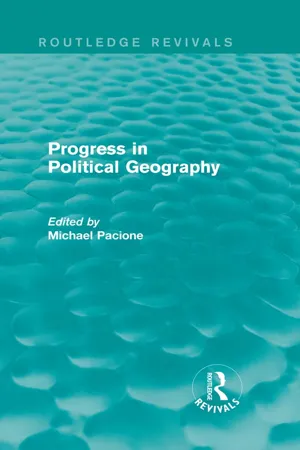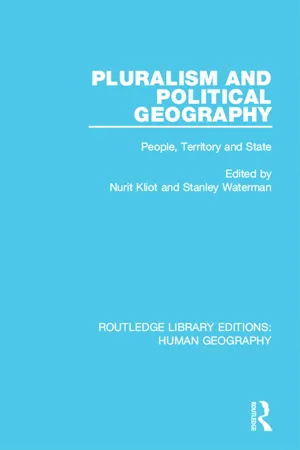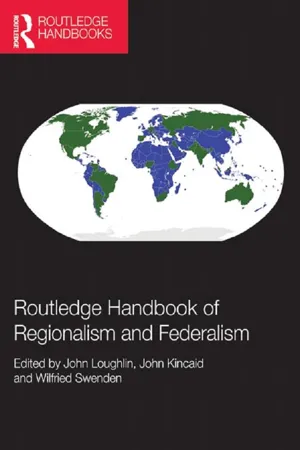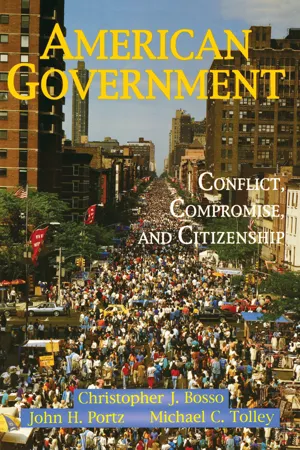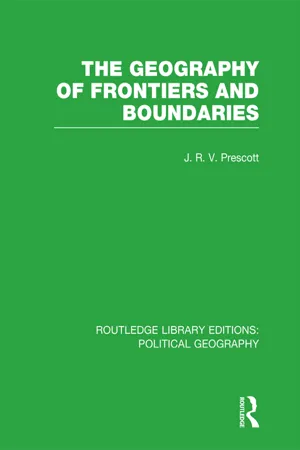Geography
Federal State
A federal state is a political entity characterized by a division of powers between a central government and constituent political units, such as states or provinces. Each level of government has its own set of powers and responsibilities, and they operate independently within their respective spheres. This system is designed to balance national unity with regional autonomy.
Written by Perlego with AI-assistance
Related key terms
9 Key excerpts on "Federal State"
- Available until 20 Sep |Learn more
Territories
The Claiming of Space
- David Storey(Author)
- 2012(Publication Date)
- Routledge(Publisher)
Territory is obviously important as land is a clear necessity for a state to exist but it also provides the state with a seat of power and a functional space in which the state operates (though its actions may extend well beyond its own territory). In addition, the state serves to inculcate a sense of territorial or national identity among the populace. This scenario is well summarized by Escolar:Gradually, all the emerging absolute states required cartographic techniques in order to represent their own geography, both for the purpose of the social legitimization of their dominions and as a means of broadcasting the geographical profile of the country throughout the realm and in order to draw up an inventory of their natural, social and human resources and to set up jurisdictional institutions to facilitate government and state administration.(2003: 32)At an elementary level, we can say that states are territorial containers (though increasingly leaky ones) which have jurisdiction (or at least claim it) over politics, economy, society and culture within their acknowledged geographic spaces (Taylor 1994). However, we need to bear in mind that territory itself results from the processes of state evolution and the mechanics of mapping and calculating space. In a sense, then, territory only exists because the state does; territory is thus more than a feature of the state, it is also an effect of the system of power relations within which states exist (Brighenti 2010a).SovereigntyIn addition to territory, there is one vitally important additional feature which states must possess: sovereignty. This is a much-debated concept but at its heart it refers to the authority of a state to rule over its territory and the people within its borders; that is, the right of the state to rule without external interference. Sovereignty implies the existence of geographic space over which control is exerted; territory is produced and claimed. However, declarations of territorial sovereignty in themselves are not sufficient. A state must be recognized by other states. In an inter-state system, if a particular state’s sovereignty is not recognized, then its legitimacy is called into question. Sovereignty is therefore not just about self-declaration, it is contingent on its acceptance by external parties. - Peter Joyce(Author)
- 2015(Publication Date)
- Teach Yourself(Publisher)
Sub-national governments are subject to considerable variation. A key distinction concerns the autonomy that such units enjoy. In Federal States such as Germany, Australia or America, power is divided between national (or federal) government and the constituent units of government. The division of responsibilities is provided for in a single source, usually a written constitution, which allocates specific functions to each sphere of government. Each enjoys autonomy in its own area of jurisdiction, which means that one may not intrude into the operations of the other. There may also be functions that are exercised jointly by both tiers of government.In both federal and unitary states a range of services are provided by subordinate authorities, termed ‘local government’, whose activities will be discussed later in this chapter. FederalismThe alternative to a Federal State is a unitary one. In unitary states, political power is centralized in the hands of the national government. Countries including the United Kingdom, Sweden and France possess such forms of government. However, unitary states often possess a unit of government that is intermediate between national and local government. These are usually regional bodies, which provide services for a relatively wide geographic area where the inhabitants share some form of common identity such as language, culture or race. Regional authorities vary according to the autonomy they possess: some exercise power that is devolved from national government, thus giving them a wide degree of control over such delegated responsibilities, while others merely function as administrative bodies whose role is to provide regional services according to guidelines laid down by national government.Key idea (3) Federalism possesses advantages derived from localities being empowered to run their own affairs. But there are also difficulties, especially in connection with the division of powers in federal political structures.- Michael Pacione(Author)
- 2014(Publication Date)
- Routledge(Publisher)
This chapter reflects the two strands of work identified in the previous paragraph, and it reviews the current situation regarding geographical analyses of local government. (‘Geographical’ is not used to confine the discussion to work by ‘professed’ geographers. The review covers all work within the context that geographers currently adopt.) Thus after a brief discussion of definitions, the chapter deals first with work analysing spatial variations in local government activity. The argument is then introduced that such work treats local governments, and those who operate them, as independent actors. Two brief case studies are used to indicate the constraints — both economic and political — upon independent action; these lead into discussions of the functions of the state in modern society and of the roles allocated to local government. The aim, therefore, is to illustrate both the diversity of geographical work on this topic in recent years and the major differences in approach that follow from the adoption of separate perspectives.Some Definitional Preliminaries
Before proceeding further, it is necessary to establish clear definitions of the major terms being used in this chapter. The state is defined here as a sovereign body, whose existence, territorial limits, and (accepted) power over its citizens are widely, if not universally, recognised, both within and without. Virtually all states contain some dissidents who question the use of sovereign powers (and most states take a spatial solution; they confine the dissidents). Many states are in some dispute with others, too — over the extent of their sovereign territories, for example. But in general, a state is a fixed territory, within which, and on behalf of whose population, power is wielded by a recognised government, that rules with the (apparent) consent of the population and whose right to rule is respected by the governments of other states. A local government- eBook - ePub
The Territorial Dimension Of Politics
Within, Among, And Across Nations
- Ivo D. Duchacek, Helena Duchacek(Authors)
- 2019(Publication Date)
- Routledge(Publisher)
The federal assertion of unity vis-à-vis other nation-states (often buttressed by an implicit or explicit elimination of the right of territorial secession on the part of any component) is coupled with a solemn commitment to a permanent internal division of political power between two sets (or orders) of government; one with jurisdiction over the whole national domain in some issue-areas, the other governments keeping their jurisdiction in other issue-areas in their respective territorial domains, whose sum total constitutes “nearly” all of the national territory. I say “nearly” since the national government usually administers directly some additional areas such as federal territories (for example, the Yukon and Northwest Territories in Canada or Guam and the Virgin Islands by the United States) or a federal district in which the national capital may be located (Washington, D.C., Canberra, Brasília, Mexico City, and New Delhi). The powers of the two sets of political authority—central and noncentral—are neither derived from nor dependent on each other. They are anchored in the federal constitution that expresses the preceding negotiation and amicable agreement among leaders of the territorial components.The presence of two government layers superimposed on the same territory, neither being at the mercy of the other, is perhaps the shortest working definition of federalism and the one I intend to use in this study. The critical feature of this definition is, in Martin Landau’s words, the independence rather than the interdependence.3 Or as a truly shorthand definition of federalism (coined in 1869) expressed it when referring to the U.S. federal union, federalism is “an indestructible union of indestructible units.”4 The latter definition separates a federal from a confederal system by ruling out secession and also distinguishes a federal from a unitary system by ruling out elimination of subnational territorial autonomy.It should be admitted at this point that, among scholars and constitutional lawyers, there is no generally accepted, satisfactory or simple definition of federalism. The Latin origin of the term foedus “compact” is recognized by all but not much more. The term “federalization,” for example, is often used to describe the process of combining territorial communities that previously had not been directly joined into a new nation or a new unit of common interest, policy, and action. Federalization often describes the opposite process of a deconcentration of power that may endow territorial communities with irrevocable autonomy and so change a unitary, decentralized system into a federal one. In other contexts federalization is sometimes understood as absorption of provincial/state powers by the federal center (nationalization). Federalism is also often used to describe the result - eBook - ePub
Pluralism and Political Geography
People, Territory and State
- Nurit Kliot, Stanley Waterman(Authors)
- 2015(Publication Date)
- Routledge(Publisher)
The Labor Government’s recognition of the states, explicit in the formal abandonment of unification, represented the acceptance of the politically inevitable; it meant also that the boundaries of the states would have to be respected, regardless of any anachronisms they might pose. One of the defining characteristics of federalism is that the territorial limits of the component states should be inviolable except for the acquiescence of the states themselves (Duchacek 1970). Save for possible minor boundary changes it is unlikely that any such body will vote for its own dismemberment. The rightness of this stability can also be supported. Were such changes possible unilaterally, presumably by legislative sanction of the central authority rather than by local secession the federal character of the state would be undermined. While the inviolability of the state boundaries is common to the federal countries, it is obviously more pronounced among the federations built ‘from below’. Both cases in which state boundaries have been altered comparatively easily lack this organic evolution. In West Germany federalism was established within a somewhat unsatisfactory territorital framework, the lander to a large extent following the post-1945 Allied Occupation zones; in India the federal government can initiate the process of territorial reform. This, together with other facets of the constitution, raise doubts as to whether India can be categorised as truly federal.Given the origins of the Australian federation it is not surprising to learn that the existing states have successfully resisted attempts for their subdivision since 1901. These attempts became most closely associated with the ‘New State’ movements, which were most active in New South Wales and Queensland. New staters argued that the existing states were too large and were politically dominated by geographical/sectional interests. Often located on the margins of the existing state the New State movements represented centre-periphery conflict. It was in the resistance to the formation of New States that the constitutional strength of the states became apparent (Whebell 1973). Some of the movements commanded sufficient local legitimacy to ‘force’ the holding of a referendum – notably New England in northern New South Wales (Woolmington 1966), though by gerrymandering the area in order to include populations that are known to be unsympathetic to secession, the position of the state was thus reasonably assured. - eBook - ePub
The Limits of Boundaries
Why City-regions Cannot be Self-governing
- Andrew Sancton(Author)
- 2008(Publication Date)
- McGill-Queen's University Press(Publisher)
2 Boundaries for Central Governments The purpose of this chapter is to demonstrate that the boundaries of sovereign states are relatively stable and have become even more so in recent years. When new states have been created, they have generally used old boundaries, often the boundaries of constituent units within the state. In federations, these constituent units – states and provinces in the United States and Canada – generally have constitutional responsibility for local government. For municipalities in North America, the states and provinces are effectively the sovereign unit of government. For the purposes of this book, it is important that we understand that they are even more important than the federal governments based in Washington and Ottawa. In this chapter, we look at the boundaries of sovereign states and then at the boundaries of constituent units in federations. But first we explore some of the more theoretical issues relating to the boundaries of sovereign states. THE OPTIMAL SIZE OF NATION-STATES Robert Dahl is one of the few modern political scientists to have paid much attention to the relationship between size and democracy. He emphasizes that the first conceptions of democracy related to the city-state and that this vision “prevailed, by and large, from the Greeks to Rousseau.” 1 According to this understanding, democracy involved debate among citizens in open meetings followed by a decision-making process in which every citizen had a direct voice. But this form of democracy eventually gave way to the kind of representative democracy we are familiar with today in our larger nation-states. Dahl is very much concerned with trying to balance the effectiveness of citizen participation, which is more feasible in smaller political units, with the capacity of political systems to accomplish collective objectives, which is enhanced in larger units - eBook - ePub
- John Loughlin, John Kincaid, Wilfried Swenden(Authors)
- 2013(Publication Date)
- Routledge(Publisher)
However, while it certainly has the theoretical quality of flexibility and adaptability necessary to find a place for just about every form of federal or federal-type polity or arrangement in the world, it also has the drawback of casting the net so wide as to muddy the conceptual waters. We are reminded of King’s observation that if our categories are too broad we can always find what we want ‘if one looks hard enough’ (King, 1982 : 35). As Murray Forsyth famously put it, ‘with sufficient effort’ federalism ‘can be detected almost everywhere’ (Forsyth, 1981 : 7). There is, then, a trade off between concepts that are highly inclusive and embrace empirical reality with great gusto and those that are more exclusive and have quite narrow empirical implications. This is, of course, an extremely old conundrum in political science, and especially in comparative politics, and King’s conceptual distinction between federalism and federation is a good example of it. The problem with using the concept of federation is that it is rigid; it recognizes only those federal models that are formally Federal States according to their written constitutions so that the scope for including new federal models that defy this standard categorization is quite limited. The conventional way of understanding the concept of federal political system in this context is, contrary to that of Watts and Elazar, to see it as conceptually subordinate to the Federal State. Logically every state has a political system – and in Eastonian terms a social and an economic subsystem – so that in this scheme we would expect to find a federal political system in a Federal State and not the other way around. Here the federal political system is construed in Stein’s sense as an outgrowth or consequence of federation which, if it works well, serves to buttress the state - eBook - ePub
American Government
Conflict, Compromise, And Citizenship
- Christopher J Bosso, John Portz, Michael Tolley(Authors)
- 2018(Publication Date)
- Routledge(Publisher)
5 Federalism made it possible to govern this vast nation.Today, even with modern telecommunications and transportation, size is still a factor. Look around the world. Regardless of whether they are considered democracies, large nations such as Russia, China, Australia, Brazil, Canada, Germany, and Mexico tend to have systems in which duties and powers are spread out among national and subnational governments. Despite its monolithic image, even the former Soviet Union—known formally as the Union of Soviet Socialist Republics—was divided into a number of subnational units. So in some respects the United States is not unique.What does vary is the degree to which real decision-making authority is spread out. The 11 provincial governments of Canada have a great deal of autonomy from the federal government in Ottawa. In France, however, the “departments” historically have done little more than administer orders coming out of Paris. Such differences usually exist because every nation has its own history and culture. In a fictional America in which the nation existed before the states, maybe the states would have been created simply to administer national programs and policies, becoming more like the French departments than the Canadian provinces.The second major reason that the new nation adopted a federal system is equally important: The states already existed. They were the nation under the Articles of Confederation.6 As a result, federalism was a practical political solution to the founders’ dilemma of how to establish a stronger national government without making the states subservient. As the scholar H. G. Nicholas writes:The unique advantage of federalism is that it makes the United States possible. - eBook - ePub
- J. R. V. Prescott(Author)
- 2014(Publication Date)
- Routledge(Publisher)
The often ephemeral nature of internal boundaries makes it much more difficult to trace their evolution in function and position than that of international and federal boundaries, which are usually defined in some published treaty. Internal boundary changes are usually published in a Government gazette, and can be very difficult to follow. Freedom of movement across federal and internal boundaries makes it easier to carry out fieldwork in respect of these two categories than is the case with most international boundaries. Lastly it seems likely that people are more aware of the influence on their lives of federal and internal boundaries than of international boundaries. This is because federal and internal boundaries may determine the level of taxation, the requirements to be observed in building a home, the state schools available for children, and the quality and quantity of cultural amenities such as libraries.The following sections consider those aspects of intra-national boundaries appropriate for geographical study and the methods which may be used. The evolution of federal and internal boundariesGeographers are concerned with the evolution of boundaries in respect of definition, function and position, and it is important to realize that evolution in these respects may be related or take place separately. For example, in 1917 the latitudinal boundary which had allocated territory between the Northern and Southern Provinces of the Colony and Protectorate of Lagos was delimited. This change in definition was accompanied by a change in position which transferred 5,650 square miles to the Northern Provinces, but the function of the boundary remained unchanged. On the other hand, in 1921 the international boundary between Eire and Northern Ireland was created from existing county boundaries without any changes in definition or position.Studies are available dealing with the evolution of the federal boundaries of the United States, Canada, Australia, the Soviet Union and Nigeria. The development of Nigeria’s federal boundaries is distinct from the other four cases: first, because the area which became Nigeria had a large settled indigenous population long before the boundaries were drawn by colonial administrators; second, because the boundaries reached their present form as the primary internal boundaries of a unitary state – the Colony and Protectorate of Nigeria; and third, because there was no attempt to colonize the area by large numbers of Europeans. In Australia and North America the boundaries were drawn in areas being colonized by Europeans, who were opposed by numerically small indigenous groups, lacking political hegemony. Nor did any of these Federal States experience a period of unitary government involving the whole of their present territory.
Index pages curate the most relevant extracts from our library of academic textbooks. They’ve been created using an in-house natural language model (NLM), each adding context and meaning to key research topics.


